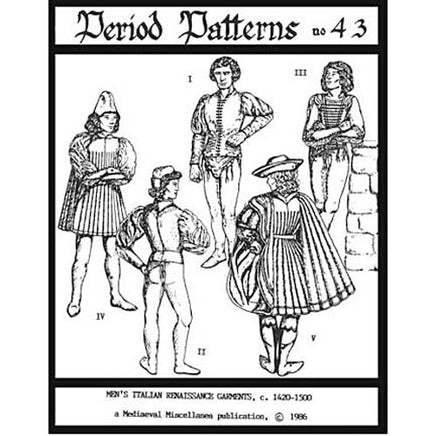
The Renaissance in Italy
Period Patterns number 43, Men's Italian Renaissance Garments, c. 1420-1500, contains patterns for 3 shirts, 3 hose, 2 codpieces, a tabard and a cioppa or gown (sizes 36-48 included).
These garments are complimented by Period Patterns no. 26, 92, 93, 101, and 102.
The Renaissance of the 15th and 16th centuries began in politically splintered Italy. The age was humanistic, like the people themselves; the clothing was individualistic, competitive, even playful. While there were broad similarities, regional variations were the norm.
Men
Men's fashions began to evolve around 1420. The cotehardie (Period Patterns #23) became the doublet, first cut with a waist seam, then rapidly shortening to waist length. Sleeves were often tied or laced on, and a sleeveless underdoublet was sometimes worn as well. This was worn over a shirt. The houpelande (Period Patterns #26) became a robe or gown opening down the front, worn open or shut, and often belted. A tabard could be worn instead of the robe, and young men often wore the doublet alone. Separate hose leggings, tied to the doublet or underdoublet, became joined at the back, and modest codpieces were worn to cover the opening in front.
Zelikovitz Leathers is an Official Distributor of Mediaeval Miscellanea Period Patterns and stocks the full line of available patterns.
Mediaeval Miscellanea has created copyrighted Period Patterns for sewing authentic period clothing. The patterns, designed by professional costumers, are rigorously researched to ensure historical authenticity. Each package includes complete, full sized cutting patterns in all sizes listed on the envelope (which permits easier custom fitting; sizes are based on standard commercial pattern sizes and can easily be scaled up or down to create additional sizes). Detailed, fully illustrated, step-by-step sewing instructions are provided in addition to general instructions (seam finishes etc.), and most patterns include suggested pattern layout.
Each pattern package contains historical notes with illustrations from contemporary sources providing background information, as well as possible enhancements and variations. On the back of the package additional important information is provided including garment description (with country and approximate dates where possible), sizing, notions and yardage requirements for each size and suggested fabric type for each garment.
